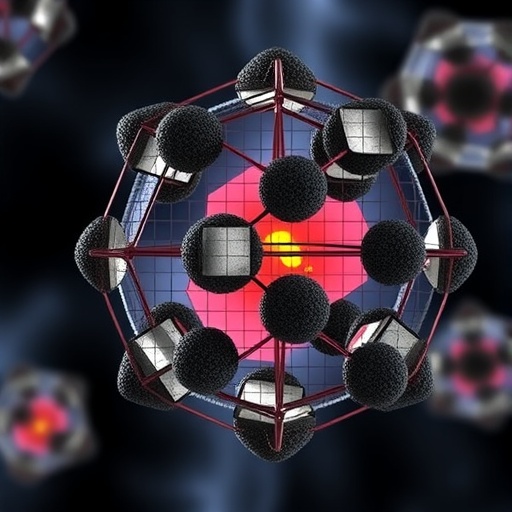Recent advances in energy storage technology have ushered in a new era of materials science, where nanostructured composites stand at the forefront. A groundbreaking study conducted by Shanmugapriya and colleagues has spotlighted the innovative synthesis of cobalt vanadium oxide (CVO) nanospheres integrated with graphitic carbon nitride (g-C3N4) structures. This research is vital as it explores ways to enhance charge storage capacities, a critical factor in developing efficient energy storage systems.
Cobalt vanadium oxide is recognized for its remarkable electrochemical properties, including high theoretical capacity and excellent conductivity. The integration of nanostructured materials such as g-C3N4 opens up new routes for improving the performance of these metal oxides. The research team utilized microwave-assisted synthesis, a technique that sets itself apart by enabling rapid and uniform heating, leading to better control over the material properties as compared to traditional synthesis methods.
The strategic addition of graphitic carbon nitride nanostructures to cobalt vanadium oxide was hypothesized to enhance the overall electrochemical performance of the composite material. Through meticulous experimentation, samples were synthesized under various conditions to pinpoint the optimal ratio of CVO to g-C3N4. The results unveiled significant improvements in both charge storage capacity and conductivity, validating the hypothesis that combining these materials can lead to superior performance in energy storage systems.
One of the standout features of this study is the use of a microwave synthesis approach. Traditional methods often involve lengthy heating times and less control over the precise characteristics of the resultant nanostructures. Microwave synthesis, on the other hand, reduces reaction times significantly while maintaining uniformity at the nanoscale. This efficiency not only improves the quality of the materials produced but also suggests a more sustainable method for large-scale production.
The contribution of g-C3N4 is multifaceted. Beyond merely acting as a conductive scaffold, it engages in physical and electrochemical interactions with the cobalt vanadium oxide, effectively enhancing its electroactivity. The structural integrity and high surface area of the carbon nitride contribute to improved ion diffusion, which is paramount in applications involving rapid charge-discharge cycles. As a result, the electrically conductive network formed between the oxide and the carbon nitride allows for enhanced electron transport during electrochemical reactions.
In their experiments, the authors conducted comprehensive electrochemical testing, including cyclic voltammetry and charge-discharge cycling, to evaluate the performance of the synthesized composites. Results revealed that the optimal composite exhibited a remarkable increase in charge storage capacity, suggesting that the interplay between the cobalt vanadium oxide and the g-C3N4 is a pivotal factor. The findings indicate that the introduction of nanostructured g-C3N4 significantly amplifies the charge storage capabilities inherent to the CVO.
The versatility of this composite material could have far-reaching implications in the field of energy storage. As global energy demands continue to rise, the need for efficient, high-capacity storage solutions becomes increasingly crucial. This research presents the potential for developing advanced batteries and supercapacitors that can deliver higher energy densities. Furthermore, the sustainable aspect of utilizing earth-abundant materials in the synthesis adds to the appeal of these nanostructured composites.
The implications of this study extend beyond the laboratory. With the increasing urgency of transitioning to renewable energy sources, such materials can play a critical role in energy systems designed to harness solar, wind, and other forms of renewable energy. Enhanced energy storage capabilities provided by such composites can lead to more reliable and efficient energy grids, ultimately facilitating a smoother transition to sustainable energy solutions.
As industries and researchers alike seek to push the boundaries of energy storage technology, the integration of advanced nanostructures will be vital. The insights garnered from this study not only add to the existing body of knowledge but also pave the way for future innovations. Researchers are encouraged to delve deeper into other composite materials that can similarly enhance charge storage capacities while providing a sustainable edge.
The use of microwave synthesis could also inspire further research into alternative energy storage materials. By optimizing production techniques and continually exploring new composite landscapes, material scientists can significantly enhance the performance characteristics needed for next-generation energy storage solutions.
In conclusion, the compelling findings from Shanmugapriya et al. set the stage for a transformative approach to energy storage. Through their innovative synthesis of cobalt vanadium oxide and graphitic carbon nitride, they have not only demonstrated enhanced charge storage capacities but have also ignited interest in sustainable nanostructured materials. As the world shifts towards greener technologies, such research milestones are pivotal in shaping the energy systems of the future.
Subject of Research: Energy storage using cobalt vanadium oxide nanostructures enhanced with graphitic carbon nitride.
Article Title: Microwave synthesis of cobalt vanadium oxide nanospheres: boosting charge storage capacity with the addition of graphitic carbon nitride nanostructures.
Article References:
Shanmugapriya, S., William, J.J., Saravanakumar, B. et al. Microwave synthesis of cobalt vanadium oxide nanospheres: boosting charge storage capacity with the addition of graphitic carbon nitride nanostructures. Ionics (2025). https://doi.org/10.1007/s11581-025-06754-8
Image Credits: AI Generated
DOI: https://doi.org/10.1007/s11581-025-06754-8
Keywords: Cobalt vanadium oxide, graphitic carbon nitride, microwave synthesis, energy storage, nanostructures, charge storage capacity, sustainable materials, batteries, supercapacitors.




